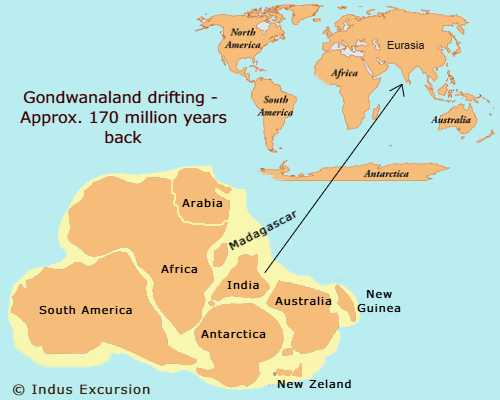
If we will do the searching with simple word Gondwana, we will get 2 type of results. One results into geological term answer indicating towards Gondwana land which existed about 180 to 600 million years ago when continents were interlocked and supercontinent was existing. It means places like India, Australia, Africa, South America, Antarctica were part of same piece of land. As here we are more inclined towards Central India region thus we will talk more about second result i.e. Gondwana region which comprises collection wide spread area in which Gond tribe is spread. It comprises areas of Madhya Pradesh, Maharashtra, Telangana, Chattisgarh, Odisha state.
As mentioned above, Gondwana region comprises a wide spread areas of multiple states in which Gond tribal society is living. They are mostly comprising the areas of wide spread Central India region. Geographically it is the area of Deccan plateau. Gond tribe is counted among indigenous communities of India who prefers to live in forested areas, close to nature with own language, culture, rituals and art. While visiting Central India region, especially the tourist destinations like Pench tiger reserve, Kanha tiger reserve, Amarkantak, Kanker, Kawardha, Dhamtari etc. we will herd more about Gond art in which these artists use to reflects his imaginary story in pictorial form in which nature will be the core subject. Due to their majority in this region, they established their own kingdom in which Rajgonds ruled the region and formed Gondwana kingdom which have great influence during the period from 14th century to 17th century. This whole region was not ruled by single ruler by a collection of many small kingdoms who were connected with each other due to common tribe, family relations, common cultural and ideology.
Very few people knows this fact that Gondwanaland have definite connection with Gondwana region of Central India. Here Deccan plateau plays the role of bridge which establish connection in between them. Deccan plateau is a huge piece of elevated land with borders as Satpura range and Vindhya range in north, Western Ghat in west and Eastern Ghat in east. It is mostly made of volcanic basalt rock with history of at least 66 million years old. If we will visit the Ghughuwa fossil park of Madhya Pradesh, while traveling from Kanha national park to Bandhavgarh or vice versa, then we will realize that this park have collection of many plant fossils, collection from local villages, hills. These collected fossils are estimated to be approx. 65 million old. Here some plant fossils are of those vegetation which are not present in Central India but found in Australia. It means somewhere in past, this region had land connection with Australia continent which was part of Gondwanaland. Thus we can establish a connection in between Gondwanaland and Gondwana region.